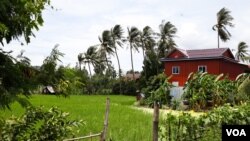Time passes, but the rice cycle remains the same. This was the essential truth for Nget Srey and other farmers in this remote village in coastal Preah Sihanouk province.
Or so it was until two years ago, when salt water started spilling over the dike containing the nearby estuary. The salt water flooded their rice fields, killing a crop that requires fresh water to thrive.
Last year, Nget Srey’s paddy was almost ready to harvest when her 2½-hectare field became inundated with seawater, wiping out her crops, slashing her main source of income and destroying her way of life.
“My paddy was really good by then, and salt water spilled over and it died out. So did other neighbors’ rice paddies,” said the 58-year-old farmer in Prey Nob district’s Champou Khmao village.
“Now I am really concerned that I can’t farm anymore,” she said.
Nget Srey and her neighbors, like other coastal farmers around the world, are feeling the effects of saltwater intrusion, a phenomenon in which seawater infiltrates freshwater sources such as groundwater, rivers and aquifers. Today, a combination of unchecked development and climate change is accelerating the process.
Coastal flooding predicted
While reports forecasting the effects of climate change in Cambodia have predicted that saltwater intrusion will threaten coastal agriculture, none described the effects.
In general terms, Cambodia’s sea level could rise by more than half a meter by 2090, inundating 25,000 hectares and forcing thousands to relocate, according to the government’s 2013 Climate Change Strategic Plan. Temperatures are expected to rise by between 0.13 and 0.36 degrees Celsius per decade.
The government’s point person on global warming said he wasn’t sure how big the problem was for farmers along the 450-kilometer coastline stretching from Kep to Koh Kong.
“There is no data showing saltwater intrusion,” said Hak Mao, director of the Department of Climate Change of the Environment Ministry, “but there might be some areas affected, and we need to study more.”
During a trip to coastal communities in early October, VOA Khmer spoke with a half-dozen farmers who said saltwater intrusion was affecting them. Some say that as their rice fields turn more saline, they are giving up rice cultivation altogether, leaving themselves without a reliable food source and a stable income.
Nget Srey, a mother of six, said she harvested only 20% of her normal paddy rice yield last season, which was hardly enough to feed her own family for the year.
Next to Nget Srey’s house lives Sorn Touch, a rice farmer who said salt water flooded his 3 hectares of paddy field late last year, costing him around $1,000.
“I have lived here for more than 30 years, and there was never such big water,” the 60-year-old told VOA Khmer.
Normally, he said, the water rises from October to December, but it was becoming less predictable — and more difficult for the dikes to hold it back.
“Salt water easily gets into our land via the dikes,” he said.
Sorn Touch and his wife, Sem Rem, 54, who have five children, also rent land nearby to grow rice to eat and sell. But they lost last year’s harvest from that plot, and about $1,500.
“Last year, I couldn’t harvest even a seed,” said Sem Rem. “This year, I’m not farming on the rented land since I am afraid of losing it again.”
Rising sea levels play role
While saltwater intrusion can be caused by a number of factors — from deforestation to river dredging — rising sea levels, caused by climate change, are a major contributor. Sea level rise is caused primarily by two factors related to global warming, according to NASA: the addition of water from melting ice sheets and glaciers and the expansion of seawater as it warms.
In Cambodia, the sea level could increase by more than half a meter by 2090 under the worst climate scenarios, which would inundate some 25,000 hectares; significantly increase vulnerability to storms; and negatively affect coastal tourism, according to a government report published in 2013.
In Kampot province, 40-year-old farmer Deu Bern said salt water destroyed half a hectare of her paddy last year.
“Now people here have stopped growing rice. There is only me doing it,” said the mother of two teenage daughters. “Some have sold their land already.”
Hang Sophea, a 38-year-old farmer in Koh Kong province, believes more could be done to address the saltwater intrusion. She notes that dikes in the area are small and often broken.
“I don’t know whom I should ask to help. But I want authorities to fix the dikes and build them higher,” she said.
The provincial agriculture department referred questions about the dikes to the provincial water resources department, which did not respond to questions from VOA Khmer.
Hang Sophea’s neighbor, Ho Sophal, 58, a rice farmer and primary school teacher, blamed the floods in part on the nearby forests being destroyed. According to a Massachusetts Institute of Technology study of the Amazon rainforest ecosystem, “tree root systems hold the soil together to slow the rate of flooding," and "trees themselves also absorb water during the rainy season.”
Ho Sophal believes the warnings that the rising sea will eventually inundate the lower areas along the coastline, and he worries that the rice fields won’t be the only thing destroyed in his coastal community.
“It is always risky to live nearby salt water,” he said. “I am concerned that a big rise in the seawater could wash villagers’ houses away in the future.”








